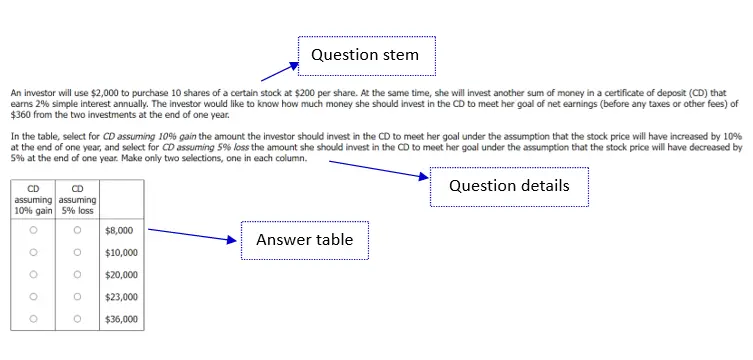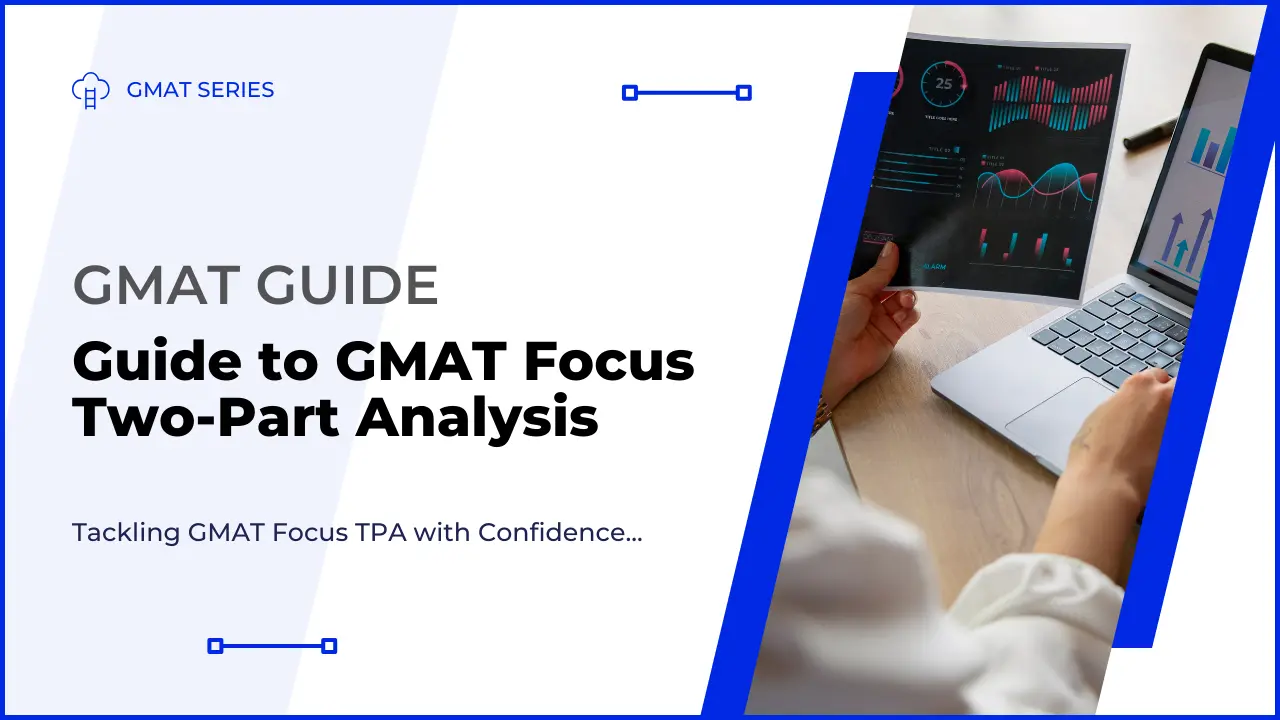Mastering Two-Part Analysis questions on the GMAT Focus requires a strategic approach akin to navigating a complex maze under pressure. These questions serve as a pivotal assessment of your proficiency in both numerical analysis and verbal reasoning. If you find yourself grappling with this section, you’re in good company.
These questions demand a unique blend of skills, necessitating both mathematical precision and astute logical thinking. Initially, they may appear daunting, but once we break these question types down for you, it’ll suddenly become far easier to tackle.
Throughout this blog, we’ll explore what sets GMAT Focus Two-Part Analysis questions apart and why they hold significant weight in your GMAT preparation. We’ll guide you through illustrative examples to provide a clear understanding of how these questions are structured. Additionally, we’ll equip you with practical strategies and actionable insights to approach these questions with greater confidence and efficacy.
By the time you reach the end of this blog, you’ll possess a comprehensive toolkit for adeptly tackling Two-Part Analysis questions.
In this blog, we will look at…
Understanding Two-Part Analysis Questions in the GMAT Focus
- Why are Two-Part Analysis Questions important?
- Structure of Two-Part Analysis Questions
- Types of Two-Part Analysis Questions
Essential Skills for Excelling at Two-Part Analysis
- Analytical Reasoning and Problem Solving
- Quantitative and Verbal Skills
- Synthesizing Information from Multiple Sources
Approach and Strategy to solve Two-Part Analysis Question
Grab your free copy of ‘Demystifying GMAT FE’
Grab your free copy of ‘Demystifying GMAT Focus Edition’
Understanding Two-Part Analysis on the GMAT Focus
Two-Part Analysis (TPA) questions form a vital component of the Data Insights section. They assess a fundamental business skill: the ability to handle data and make informed decisions. This question type specifically evaluates how effectively you can solve complex problems with two interrelated parts.
Two-Part Analysis questions are designed to emulate real-world business challenges, and doing well in these questions demonstrates strong analytical and problem-solving abilities, skills that are highly valued in the business world. These questions offer business schools valuable insights into candidates’ capacity for managing data-driven decision-making, crucial in today’s data-centric business landscape.
Now, let’s delve deeper into the structure of these questions and explore the best strategies to tackle them effectively.
Structure of Two-Part Analysis Questions
In Two-Part Analysis questions, you’ll be faced with a unique type of problem. Here’s what you can expect:
Question Stem: This part presents the main information and sets up the problem you need to solve.
Question Details: Here, you’ll see two columns that contain specific details or components of the question.
Answer Table: This table will have three columns, offering 5 to 6 choices for each column. You must select one option from each of the two columns to answer the question correctly.

It’s important to be careful with your selections. Unlike typical questions where you might guess from five options, here the combination of choices across two columns can create up to 36 different possibilities. This means that simply guessing could lead to a low chance of success—about 2.7% if there are 36 combinations. Therefore, it’s better to approach these questions with a clear strategy rather than relying on guesses.
Let’s look at a question…
ABC Technologies currently has both male and female employees working in its company. ABC management decided to have equal number of male and female employees in the company, by reducing its current total male employees by 33 1/3 percent and increasing its current total female employees by 25 percent.
In the table below, select a value for the number of male employees currently working in ABC technologies and a value for the number of female employees currently working in ABC technologies that is consistent with the information provided. Make only two selections, one in each column.
Table with 5 or 6 answer choices

| Male Employees | Female Employees | Percentage of Female Employees |
|---|---|---|
| 0 | 0 | 25 |
| 0 | 0 | 40 |
| 0 | 0 | 50 |
| 0 | 0 | 60 |
| 0 | 0 | 75 |
| 0 | 0 | 100 |
As you see above, you will be given a question stem, followed by a paragraph about the actual question, and then a table where you have two columns and one more column with answer choices common to both the questions.
Remember, you have to get both questions correct to get credit for this question type.
Types of GMAT Focus Two-Part Analysis Questions
Two-Part Analysis questions in the Data Insights section of the GMAT Focus Edition can take various forms. Let’s explore the different types of Two-Part Analysis questions:
1) Table Analysis Questions: These questions present a table of data that can be sorted on various columns. Test-takers are required to analyze the information in the table and determine whether a set of statements following the table is true or false based on the given information.
2) Quantitative-based Questions: These questions involve mathematical calculations and require test-takers to apply their quantitative reasoning skills. Candidates may encounter questions that involve arithmetic, algebra, or other mathematical concepts.
3) Logical Reasoning Questions: These questions test a candidate’s ability to apply critical reasoning skills to analyze arguments, identify strengths and weaknesses, and make logical inferences based on the given information.
4) Verbal-based Questions: These questions require test-takers to analyze and evaluate arguments, identify assumptions, and assess the impact of additional information on the given scenario. They test a candidate’s ability to understand and apply verbal reasoning skills.
5) Data Sufficiency Questions: These questions present a problem and two statements. Test-takers must determine whether the information provided in the statements, either separately or together, is sufficient to solve the problem.
Essential Skills for Excelling at Two-Part Analysis
To excel at Two-Part Analysis questions, along with quantitative reasoning skills and verbal reasoning skills, candidates need to develop analytical reasoning skills. You also need to be adept at synthesizing information from various sources.
Let’s look at each skill in detail…
Analytical Reasoning
Critical for Understanding: Analyzing allows you to dissect complex questions, making it easier to see the problem’s core and its elements.
Key to Effective Solutions: Problem-solving skills help you select the best strategies and apply them, ensuring you can adapt to various question formats and complexities during the exam.
Quantitative and Verbal Skills
Quantitative Proficiency: Being proficient in quantitative skills makes it easier to tackle numerical calculations and apply mathematical concepts, helping you solve quantitative problems accurately and efficiently.
Verbal Ability: This skill is important to understand and interpret the written information in the questions, ensuring you can respond to verbal and comprehension-based challenges effectively.
Synthesizing Information from Multiple Sources
Combining Information Skillfully: This skill is crucial for questions that present data in different formats. The ability to accurately combine information will help you blend the data in different formats into a single, coherent answer.
Developing a Comprehensive View: Having the skill to integrate various data points allows you to grasp the bigger picture, which is vital for making well-informed decisions that are based on the full scope of the information provided.
Grab your free copy of ‘Demystifying GMAT FE’
Grab your free copy of ‘Demystifying GMAT Focus Edition’
Approach and Strategy to solve TPA Questions
The best part about the Two-Part Analysis questions is that both the columns (questions) are linked. So even if you are solving one question, you can still get the answer for both.
To effectively tackle Two-Part Analysis questions, follow the DLS strategy:
Dissect: Dissect the information provided in the question stem.
Link: Identify the link between the 2 questions!
Solve (Strategy): For a quant Two-Part Analysis questions, use strategies of plugging in and backsolving since all the answer options contain variables
For a verbal TPA, read the entire prompt carefully and hold onto relevant information that will help to answer the questions
Let’s solve a question using this approach and strategy!
ABC Technologies currently has both male and female employees working in its company.
ABC management decided to have equal number of male and female employees in the company, by reducing its current total male employees by 33 1/3 percent and increasing its current total female employees by 25 percent.
In the table below, select a value for the number of male employees currently working in ABC technologies and a value for the number of female employees currently working in ABC technologies that is consistent with the information provided. Make only two selections, one in each column.

| Male Employees | Female Employees | Percentage of Female Employees |
|---|---|---|
| 0 | 0 | 25 |
| 0 | 0 | 40 |
| 0 | 0 | 50 |
| 0 | 0 | 60 |
| 0 | 0 | 75 |
| 0 | 0 | 100 |
Let’s solve this question using the DLS strategy:
Dissect:
Let “a” be the number of male employees and “b” be the number of female employees.
Given that, a-1/3 a=b+1/4 b
2/3 a=5/4 b
a/b=15/8
Link: Here, both the columns (questions are linked) as “a” and “b” were in the ratio of 15:8
Strategy: Use back-solving (options) approach to solve further.
The number of males (value of a) has to be a multiple of 15. So in the first column we can eliminate Options A, B, C and F.
If the number of males is 60 (answer choice – D), then the corresponding number of females would be 32, so the ratio would be 15:8. But we don’t have 32 in the second column. So eliminate answer choice D.
So, the only possible option for first column would be Option E (75).
Hence, the corresponding number of females would be 40 (Option B) in the second column, such that ratio between them is 15:8.
So, the correct answers are E (75) and B (40) for the first and second column, respectively.
Always Pay close attention to the answer choices and check what must be true, could be true, and what absolutely can’t be true.
Common Pitfalls in Two-Part Analysis Questions
When tackling Two-Part Analysis questions on the GMAT, it’s important to be aware of common pitfalls that could hinder your performance. Misinterpreting the requirements of the question, overlooking critical data points, and poor time management are frequent mistakes. To excel, ensure you fully understand the question and all provided data, and manage your time effectively. Prioritize questions by difficulty, and if you’re stuck on one, move on and return to it later if possible. By adopting these strategies, you can avoid common errors and boost your chances of success in the integrated reasoning section.
Misinterpreting Question Requirements
Navigating Two-Part Analysis questions on the GMAT can be tricky. Here are some clear steps to avoid common pitfalls and ensure you choose the right answers:
Thorough Reading: Always start by reading the question carefully. Understand every detail to avoid any misunderstandings.
Analyze Verbal Prompts: Pay close attention to the verbal prompts and refer back to any associated tables or charts for relevant data.
Watch for Specifics: Note any conditions or constraints mentioned. Consider how these specifics might affect the answer choices.
Double-Check Uncertainties: If you’re unsure about the question’s requirements, don’t rush. Take a moment to reread the question and clear up any doubts.
Alignment with Requirements: Ensure that your chosen answer aligns with all the given information and accurately meets the question’s demands.
Overlooking Critical Data Points
When facing Two-Part Analysis questions on the GMAT, missing out on key data points in the table can seriously affect your performance. Here are some steps to ensure you capture all the essential information:
Detailed Analysis: Take your time to thoroughly analyze all the numbers provided in the table. Every piece of data can offer insights that are crucial for solving the problem.
Connect the Dots: Always relate the information from the table to the question asked. This helps in understanding what the data signifies and how it impacts the answer.
Continuous Reference: Don’t hesitate to refer back to the table multiple times during your solution process. This ensures that you don’t overlook any important data points.
Thorough Interpretation: Before jumping into calculations or drawing conclusions, take a moment to interpret and fully understand the data presented.
Time Management Mistakes
Time management is key in the integrated reasoning section of the GMAT, especially when dealing with Two-Part Analysis questions. Here are some strategies to help you manage your time more effectively:
Develop a Time Allocation Strategy: Assess each question’s difficulty and importance. Allocate more time to questions that require deeper analysis and prioritize simpler, more straightforward questions.
Be Flexible with Question Order: If you find yourself stuck on a particular question, don’t hesitate to skip it and return later if time permits. This helps prevent wasting time on a single challenging question.
Focus on Score Maximization: Since partial credit is not awarded in the integrated reasoning section, it’s crucial to wisely manage your time to answer as many questions correctly as possible.
Strategic Time Spending: Make informed decisions about when to invest more time in a question and when to move on. This approach will help you avoid careless mistakes and ensure that you complete the section within the time limit.
Recommended Resources
Practice is key to mastering Data Sufficiency questions and achieving a high score on the GMAT exam. Here are some resources that you can use to practice and improve your skills:
GMAT™ Official Guide 2023-2024: eBook & Online Question Bank: This guide is a comprehensive resource that includes an eBook and an online question bank, offering a wide range of practice questions and answer explanations covering all sections of the GMAT.
GMAT™ Official Guide Data Insights Review 2023-2024: eBook & Online Question Bank: Focused on data analysis, this guide provides detailed insights and strategies for handling the data-driven aspects of the GMAT, supplemented by an eBook and an online question bank for targeted practice.
GMAT™ Focus Official Practice Questions – Data Insights: This set offers specialized practice questions designed to improve skills in interpreting and analyzing data and is ideal for mastering the Data Insights sections of the GMAT.
GMAT™ Focus Official Starter Kit + Practice Exams 1 & 2: A starter kit for new GMAT test-takers, featuring introductory materials, tips, and two full-length practice tests to simulate the actual test experience.
GMAT™ Focus Official Practice Exams 3 – 6: A continuation of the GMAT practice series, this package includes four additional full-length practice exams, helping candidates to further refine their test-taking strategies and timing.
GMAT Club: GMAT Club is a popular online community where you can find a wealth of resources, including practice questions, explanations, and discussion forums. Engaging with the GMAT Club community can provide valuable insights and help you refine your problem-solving techniques.
GMAT Prep Courses: Explore Crackverbal’s specialized GMAT prep courses, such as GMAT Live Online, GMAT Personal Tutoring, and GMAT Fast Track, each designed to enhance your skills in Data Insights questions and other question types.
Conclusion
In conclusion, mastering the art of Two-Part Analysis in GMAT Focus is essential for achieving your target score. Understanding question structures, honing analytical skills, and synthesizing information are key components. Be wary of common pitfalls like misinterpreting requirements and time management errors.
With dedication and practice, you can excel in this section. Remember, preparation is key to success. Stay focused, practice consistently, and utilize recommended resources to enhance your skills. Embrace the challenge, avoid pitfalls, and aim for excellence in every Two-Part Analysis question you encounter on your GMAT journey. Your hard work will pay off!
But if you’re looking for additional support or a different perspective, our expert GMAT Advisors are here to help. Let’s tackle this challenge together and pave your way to success!





0 Comments